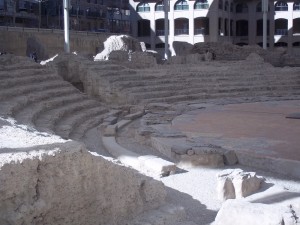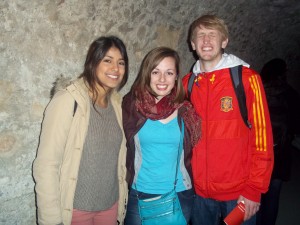Just a disclaimer: my inner history nerd may or may not emerge during the course of this post. Anyway, now that you’ve been warned…
Something that will continually fascinate me about Europe is just how OLD it is. As rich as North/South American history is, we were just a baby hemisphere in the 1700s when we were getting colonized and industrialized. In fact, compared to the Europeans, we’re still babies. I don’t mean this in the sense that we were devoid of civilization until the 1700s, because we weren’t. What I mean is that Europe, unlike the United States, is brimming with physical reminders of civilizations past – many of them dating back to centuries, even millennia before even the oldest buildings in the States were built.
I consider myself to be more than lucky to be living in a city where this phenomenon is so clearly represented. Zaragoza was founded by Caesar Augustus’ empire sometime between the years 25 and 12 BC as, essentially, a retirement village for war veterans. Throughout the centuries, the name of the city morphed from “Caesaraugusta” to “Saraqusta” (during the Moorish/Arab regime from about the 7th-11th centuries AD) to its current, more Spanish/Catholic name “Zaragoza.” The evolution of Zaragoza’s name is a really fantastic representation of how the city’s culture has also changed throughout time, and it gives me the chills to walk through the Roman ruins with the knowledge that once upon a time, 2000+ years ago, there were people just like me living here. In fact, history points to evidence that Saint James often walked along the banks of the Ebro river and lived in the Zaragoza area. (The landmark cathedral of Pilar, built in the 1400s, began as a chapel/altar built by Saint James after an apparition of the Virgin Mary to him while he was praying by the river.) Call me cheesy, but it really does feel like I’m living in a time machine, or as close to one as I’ll ever get.

The Cathedral Pilar (left), built in the 1400s, on the banks of the Ebro River. It's evolved over time to the impressive building it is now, and began in the 1st century as a tiny chapel built by Saint James.
What’s cool about Zaragoza, though, is that much of its architecture points ahead to the future as well as back to its roots in the past. In 2008, the city hosted the World Expo, which was built around the theme of water and sustainable development. The Expo itself was something of a flop, and didn’t generate as much income for the city as was expected. It did, however, provide Zaragoza with some fascinating examples of modern and futuristic architecture that amplify my little “time machine” mentality even more. In fact, my favorite bridge is named “The Bridge of the Third Millennium”. This city is rooted in a fascinating history, and looks to the future with anticipation. To me, that’s a really cool and very unique juxtaposition.
There aren’t many ways I can describe it accurately and in a way that does it justice, but the fact that evidence from the Roman empire sits on the same riverbank as examples of futuristic engineering is a concept that is endlessly fascinating to me and gives me the goosebumps to think about. It’s something that is unique to Europe (and in this case, specifically to Zaragoza), and sort of serves as a connection to the ever-changing effects of time. No, I can’t go back to the Roman empire, the age of the Crusades, or the Medieval Rebirth. I can’t go back to the Spanish Civil War, and I can’t venture into the third millennium. But exploring all that this city has to offer is a pretty good way to come close.




April 9, 2014 at 11:03 pm
I simply want to say I am beginner to blogging and certainly enjoyed your blog. Most likely I’m planning to bookmark your blog post . You absolutely have really good posts. Bless you for sharing your blog site.